Barbarossa 1941 – USSR Invaded 75th Anniversary Series [Part Two]
June 27, 2016 by crew
Welcome back, Beasts of War, to our 75th Anniversary review of “Operation Barbarossa,” Germany’s massive initial invasion of the Soviet Union. Opening on June 22th, 1941, this assault ignited what is known today as the “Eastern Front,” four years of the most brutal warfare in history … and by far the most important part of World War II.
In Part One, we saw the Axis hurl four million men across the Soviet frontier, backed by thousands of tanks, aircraft, and artillery pieces. We gamed one of the first tank clashes on the Eastern Front, together with the first desperate Soviet counterattacks. Now we shift south to the Ukraine, and one of the largest tank battles there’s ever been.
The Battle of Dubno
June 24th - 27th, 1941
While German spearheads were making runaway gains in the north toward Leningrad and in the centre towards Minsk, things in the south were proving a little more sticky. Despite tremendous gains and devastating damage inflicted on the blindsided Soviet forces, German spearheads into the Ukraine were moving far slower than planned.
There were two basic reasons for this. First, Soviet planners had assumed that any possible invasion would target the Ukraine for its rich agricultural and industrial resources, so more forces were deployed here. Second, the general commanding in the Ukraine was Mikhail Petrovich Kirponos, a cut above other Soviet generals at the time.
When the Army Group South attacked the Ukraine on June 22th, 1941, Kirponos reacted quickly. No less than six Soviet mechanized corps (over 2,500 tanks) were massed into a combined counterattack against the front, left, and right flanks of First Panzer Group, the huge armoured spearhead commanded by Colonel-General Ewald von Kleist.
The Germans ran into the first part of Kirponos’ attack (22nd Mechanized Corps) on June 24th, starting a series of engagements that are sometimes called the Battle of Brody, Battle of Rovno, or Battle of Dubno. Whatever the name, it would last four days and involve more tanks than any other part of Barbarossa.
In fact, this would stand as history’s largest single tank battle until the Battle of Kursk in 1943. Kleist’s whole panzer group (thirteen divisions, including five panzer and two motorized divisions) would be struck by elements of all six of Kirponos’ mechanized corps, totalling twelve tank divisions and backup infantry and artillery.
Again, these Soviet units were hardly full-strength, but suffice it to say that this was one hell of an explosion that had many on the German general staff genuinely worried.
As massive and well-conceived as Kirponos’ attack plan was, it was crippled by two major problems. First, the Germans absolutely owned the sky. Every move Kirponos’ tanks made was spotted and reported, quickly bringing down the screaming Junkers Ju-87 “Stuka” dive-bombers.
Also, Kirponos was working against the Red Army itself. Not enough radios, fuel, ammunition, or spare parts … an inexperienced officer corps, bad roads, poor coordination, all the connective tissue that holds an army together, all of this was completely lacking and effectively doomed Kirponos’ counterattacks before they could really begin.
The result was a spasmodic, uncoordinated series of attacks. Never were Kleist’s panzers hit all at once. Instead they were able to pivot and apply their full strength against each Soviet attack in turn, like the hero in a bad martial arts movie surrounded by enemies who all make the fatal mistake of attacking him one at a time.
Still, the Germans were horrified at the sheer scale of the Soviet attack. Kirponos hit Kleist’s one panzer group with more tanks than were possessed by the entire German Army. Not only were the German tanks badly outnumbered, they were also woefully outclassed by two famous tank designs, the KV-1 heavy tank, and the incomparable T-34.
The KV-1 (named for Klimenti Voroshilov, Soviet general and crony of Stalin’s) was a heavy tank, armed with a 76.2mm main gun that outclassed the 37mm and 50mm guns on German tanks. The KV also carried thick armour that made it impervious at anything the Germans had short of a direct hit from one of their 88mm “FlaK” guns.
While the KV was formidable, the T-34 was nothing short of revolutionary. Many consider it the “grandfather of the main battle tank,” a design with firepower, protection and mobility all in equal superlative measure. One key design feature was the slope to its armour, making it more likely that an enemy shot would glance off its face when struck.
However, these early T-34s were not perfect. Only the company commanders had radios, meaning they had to command their platoons with signal flags. Ammo was badly stored. There was no gunner, the commander had to operate the main gun himself, making it hard to command the tank properly, much less a platoon or company.
Kirponos’ basic plan was for the 22nd Mechanized Corps to hit Kleist’s panzer group from the front, halting them long enough for the 9th and 19th Mechanized Corps to hit them from the north. Meanwhile, three more mechanized corps (8th, 15th, and 4th) would hit them from the south.
These northern and southern attacks were meant to slice behind Kleist’s spearhead and meet at Dubno, thereby cutting off the panzer divisions the way the Germans were doing to the whole Red Army along the entire front. But these kinds of attacks require practised coordination. The Germans had it. The Soviets didn’t.
Although the Germans would experience some panicked moments, their fast, agile, and well-coordinated panzer divisions (9th, 11th, 13th, 14th, and 16th Panzer Divisions, forming the basis of III, XIV, and XLVIII Motorized Corps) were able to pivot time and again, smacking down each disjointed Soviet attack and quickly turning to face another.
Although facing the KV and T-34 for the first time was definitely a shock, many of these machines were abandoned when they broke down, threw a track, or simply ran out of fuel. German gun crews also soon developed tactics against them, like immobilizing them with track shots or drawing them into traps of flanking fire.
In the end, the Soviet pincers were unable to close at Dubno. Although German losses were heavy, Soviet losses were catastrophic, particularly among their tank divisions. The 10th Tank Division (15th Mechanized Corps) went from 205 tanks to about twenty in two days. The 22nd, 8th, and 4th Mechanized Corps were all but annihilated.
The surviving Soviet forces had no choice but to pull back, giving up their defence of L’vov, falling back through Zhitomir and finally towards Kiev, the capital of the Ukraine. Still, the Battle of Dubno slowed the advance of Army Group South by at least a week, something that no one else on the Soviet line was able to say.
A War of Rivers
Guderian at the Dniepr
As the Battle of Dubno raged and subsided in the south, in the centre, panzer generals Guderian and Hoth pushed their armoured spearheads ever deeper into the Soviet hinterland. After taking Minsk and sealing some 330,000 Soviet troops in Bialystok Pocket, they raced eastward toward the mighty Dniepr River.
This is a massive river, taking a winding course from north to south across thousands of kilometres of Russian and Ukrainian steppe. Indeed, the Eastern Front would be in many ways a “War of Rivers” – the Dniepr, the Don, the Donets, the Dvina, and the fateful Volga, where the Germans would one day come to grief at Stalingrad.
But for now, Guderian wanted to get bridges across the Dniepr, and fast. If he waited too long the Soviets could use the reprieve to organize strong defences along the opposite river bank. Guderian therefore ordered an immediate infantry attack in assault boats, which we will recreate in a game of PanzerBlitz.
The gamble was dire. Guderian had bypassed many pockets of resistance and his rear was far from secure. General Hoth’s Panzer Group III was lagging behind in the north, leaving Guderian’s left wing exposed. But they didn’t call Guderian “Fast Heinz” for nothing. On July 11th, he hurled the 29th Motorized over the Dniepr at a town called Kopys.
The Germans had only outboard assault boats, many of them wooden. Needless to say, they’d be horrifically vulnerable making the crossing on open water. Only by seizing the moment and attacking while the Soviets were still reeling from recent defeats did the Germans stand a viable chance.
The Germans also enhanced their odds with massed artillery and air strikes, wreaking terrible damage to any Soviet unit on the far river bank. On the operational level, such interdiction also prevented the Soviets from bringing up any reinforcements or mounting reserves for an immediate counterattack.
Once across, the infantry then had to expand the bridgehead to a sufficient depth to allow German engineers to build first pontoon, then permanent bridges. Only then could the heavy artillery, panzers, fuel trucks, and supply convoys rumble over the river, reform, and continue the advance still deeper into Russia and the Ukraine.
Once Guderian had one or two bridges across the Dniepr, the Soviet defence fell apart quite quickly. Panzers and motorized grenadiers fanned out, attacking other Soviet positions from the east side of the river. More and more crossing points opened, and soon Panzer Group II was again pouring toward the east.
As with most military obstacles, it’s like knocking down a wall with a crowbar and hammer. The difficult (and bloody) part is getting that first crack. Once you get a crowbar in that crack, you can start to pry it wider. Pry it wider, and you can get more leverage and hit that crowbar with a bigger hammer. Soon enough, the wall is rubble.
By the end of July, the Germans had pushed 500 miles deep into the Soviet Union in place. The Red Army had basically been annihilated, but a new Red Army was already taking its place. Come back next week as we take a look at German advances in the north, and Hitler makes one of the greatest operational blunders in history.
If you have an article that you’d like to write for Beasts Of War then you con get in contact with us at [email protected] to find out more!
"...all of this was completely lacking and effectively doomed Kirponos’ counterattacks before they could really begin"
Supported by (Turn Off)
Supported by (Turn Off)
"Guderian therefore ordered an immediate infantry attack in assault boats, which we will recreate in a game of PanzerBlitz..."
Supported by (Turn Off)































![How To Paint Moonstone’s Nanny | Goblin King Games [7 Days Early Access]](https://images.beastsofwar.com/2024/12/3CU-Gobin-King-Games-Moonstone-Shades-Nanny-coverimage-225-127.jpg)









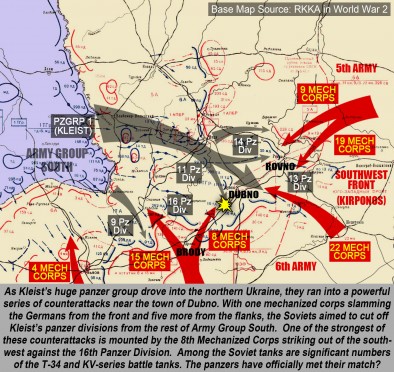
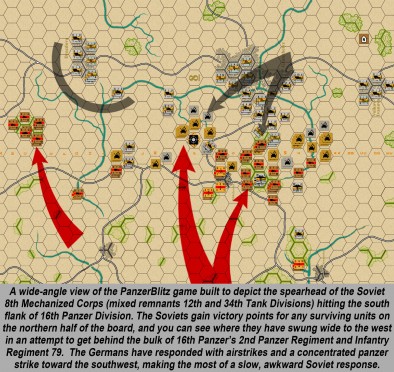
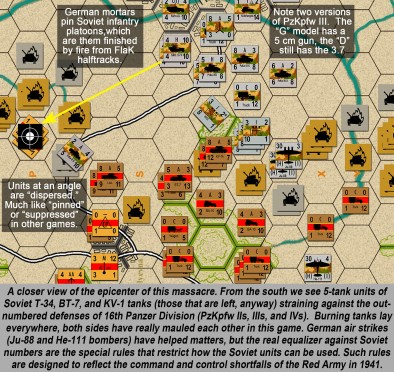
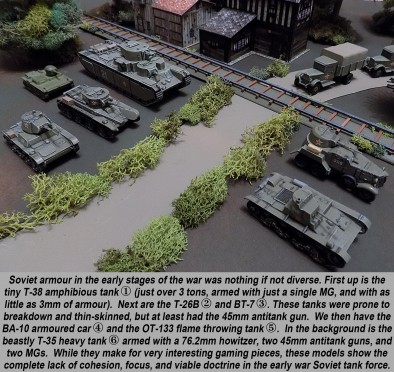
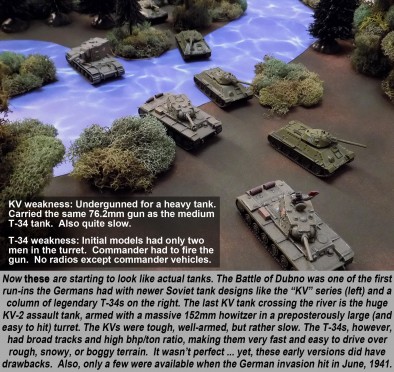
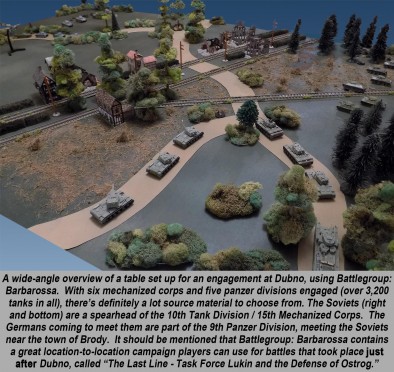
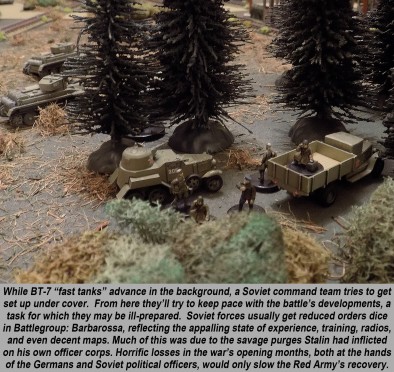
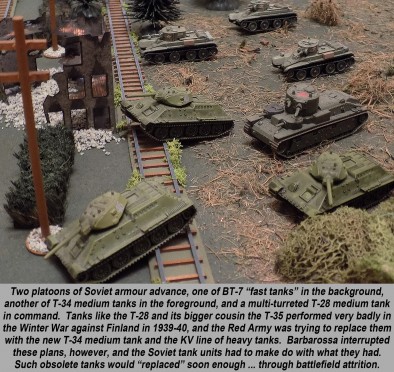

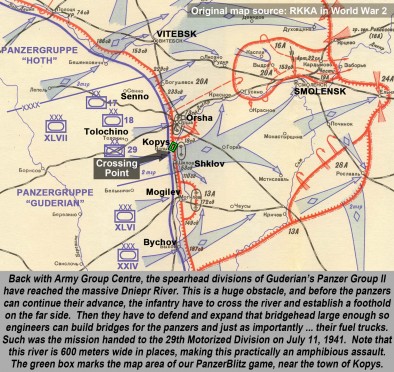
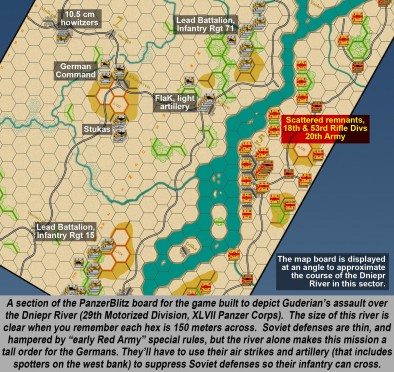
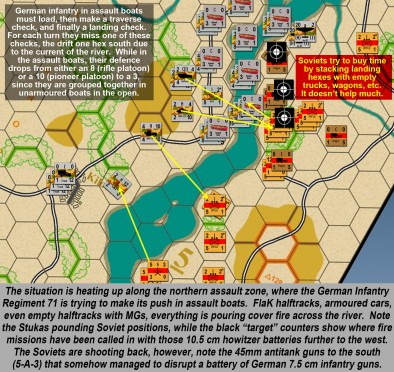
































Good one @oriskany 🙂 The Dubno – Luck – Brody battle, at least preparations to it, showed the lack disorganization of the Russian forces. Well, sorry, it is hard to talk about preparations with such a dynamic change of the situation. Yet, the orders given to the units before the battle took place were changing a lot. Let’s take the 8th Mechanized Corps that you write about. On the 20th of June it got on alert. On the 22nd of June it moved towards Sambor just to get an order, in the evening to move into the Kurovice-Vinniki sector and… Read more »
Awesome poast, @yavasa – and great detail! Especially on the 8th Mechanized Corps. Most of the detail I have on this revolves around Rokossovsky’s 9th Mechanized Corps because it contains the 20th Tank Division, commanded by my favorite Soviet general, M. E. Katukov. I’ve done a lot of reading on Katukov, and he describes what the movement toward the Dubno-Brody battle was like. The infantry have no trucks so they have to ride on the tanks. The tanks have to drive waaaay too far on the roads when they should be carried on trains and then debarked much closer to… Read more »
@oriskany great post. I have to agree with all that you write above. I did manage to find something on the web that might interest you. Here you go, the account of the 8th Mechanized Corps commander Ryabyshev. A splenid read that actually proofs on the level of a Corps all the holistic points made about Barbarossa’s first days.
http://english.battlefield.ru/battles/22-1941/84-8th-mechanized-corps1941.html
That is indeed a great page you have linked, @yavasa . I have saved it as a bookmark and will go through it in detail on my lunch break today! 😀 (We’re coming up at end of quarter at work so we’re working strange hours)
The site is actually not bad. It has some moments thou. Like for example when they try to argue that Polish officers shot at Katyn was not a Soviet thing…
Yeah, that’s pretty terrible. But that’s the thing with veterans’ accounts. I mean, they lived it, they were there, and they have a singular perspective that absolutely cannot be matched by any subsequent historian. And, sadly, as time marches on, their accounts become fewer and fewer and accordingly more invaluable. On the other hand, it’s exactly this “we were there” quality that fatally flaws so much of their accounts from perspectives of objectivity, analysis, and clarity. If you were there, you’re emotionally invested so delivering an unbiased account becomes very difficult. Accordingly, a lot of veterans’ accounts are deeply saturated… Read more »
Too early for a pint … so a pot of coffee it is … lean back and read
Drowning in coffee myself at the moment, @rasmus 😀 Welcome to the States, if your move is finally completed. 😀
Thanks for the welcome.
Almost complete, stopping over at the in-wars for a week
Well, if you can survive a week at the in-wars, you can survive anything. 😐
330,000 men lost in a single encirclement … *ouch*
There are no small losses in this part of the war.
The Germans should have considered themselves lucky the Soviets had such problems ordering their troops.
You kind of get to see the result of that when the soviets strike back in operation Bagration.
I suspect that’s why the rest of the allies were kind of afraid of the Soviets near the end of the war …
Stalin bumped off the soviet Unions best generals in the purges before the Great Patriotic war, they were sorely missed
Indeed, @limburger ,and unfortunately for the Soviets, this would be just one of dozens of such encirclements. And they would get bigger. Kiev would encircle or destroy by combat upwards of 650,000 in September, and the October disasters at Vyazma would (when combined) total out at over 700,000. Granted, most of these casualties are prisoners of war. But that’s where the Eastern Front’s real death toll takes place (well, that and among the civilians). The fact that between 3-6% of PoWs on either side ever see their homelands again is part of what drives up the Eastern Front’s butcher’s bill.… Read more »
I don’t know why but I love the T35 useless tank, I think it is just the idea of it armaments 3 full guns and a few MGs.
I feel odd saying it but this is properly my favorite part of the War. I know lots and lots died. but game wise it is the most interesting – asymmetrical
I totally know what you mean, @rasmus, on both counts. The T-35 is a wretched thing, historically and in game stats (both in Axis & Allies 15mm and in Battlegroup: Barbarossa). But I still can’t suppress a girlish giggle whenever I put it on the table. I mean look at that thing! Now, the T-35 does get to use the “Multiple Turrets” special rule in Battlegroup. Give it an “Open Fire” order and if it rolls a 5+, it gets to fire a third time (normally Open Fire lets you fire twice). It’s only happened a few times for me,… Read more »
I tell you what, I foresee being forced down to an amusement park round your neck of the woods. I’ll have to take on you Red Army – I will take a look at building a historical 1941 Heer
Oh no … it sounds like you may be dragged to the “Orlando Gulag,” run by Kommissar Disney and his evil Mouse minions!
Sounds good, @rasmus – I have a big 15mm Soviet force for all periods of the war, or we could go the hex and counter route. 😀 Orlando is only about three hours from where I’m out, gimme a shout with enough warning and I can probably meet you up there.
We are talking winter, this one or the next – as you might have guessed I don’t do well in heat. Nor do the rest of the family, both of them also being gingers
Awesome, @rasmus – just a word of warning. Travelling to Florida in winter, the weather is absolutely gorgeous, its the reason you put up with the heat, the hurricanes, and the (*ahem*) tourists (just kidding).
But coming here in the winter has two drawbacks: More expensive. And more crowded. Everyone wants to come here in the winter, and the crowds and prices reflect it.
Another fabulous article!
Thanks very much, @dorthonion ! I was starting to wonder if they were getting too long, but there’s a lot of ground to cover. 😀
a great article didn’t know that the Germans were actually slowed by any one at the beginning of Barbarossa. @oriskany
Actually yeah, in the south things were measurably more rocky for the Germans pretty much from the start.
I mean they were still winning, closing huge encirclements and winning massive battles like Dubo-Brody, Uman, eventually Kiev (Part 03). But bigger Soviet armies, smaller German armies, the phased introduction of their allies’ forces (Romanians, Hungarians, etc, they didn’t all come in at once), and a very wide battle front (tougher to achieve the local concentrations of force required for the Blitzkrieg doctrine), and most of all, a better Soviet commander, I think made a big difference.
can’t wait.
Very cool article. You can really tell the passion you feel for the subject area. I can’t believe I have never heard of the Battle of Dubno, Kursk yes but not Dubno. Was it because it was eclipsed by Kursk as far as numbers and importance/influence on the war?
Also, the train tracks came out looking sweet!
By Kursk and by Stalingrad and a few other in importance, even Kiev shortly after.
Yeah, good call, @rasmus – Kiev is one of those “stealth” turning points not many people think of. It’s just a personal opinion, but I’ve always felt that most of history’s “turning points” are really nothing of the sort. They’re “always late,” just confirmations of trends and trajectories that have long been on course. Maybe it wasn’t obvious at the time, but by the time the “big turning point” (i.e., Stalingrad, Kursk) rolls around, the issue is well and truly decided. I mean, did Waterloo really doom Napoleon’s empire? Of course not. That was done long ago at Leipzig, some… Read more »
Thanks, @zorg and @gladesrunner .
Yeah, those rail road tracks were just put together with some balsa wood. The base pieces and rails were easy enough, the only tedious part were all those railroad ties. I made twelve feet of the stuff, with about 450 of those tie boards cut (very thin balsa wood square dowels).
Not many people (at least in the West) have heard of Dubno. One reason may be cause it has three names and with practically every book you pick up, they choose another of the three (Dubno, Brody, or Rovno).
Good old training on Panzer General coming in here … Kiev seems to be the turning point you need the major victory or you are doomed
Ah … Panzer General. Ah … Barbarossa. 😀
https://www.youtube.com/watch?v=Qn5Z5Ly3fqQ
https://www.youtube.com/watch?v=-Y9pvkcxH7Q&index=3&list=PLuXk2Ke3aaAgm8htbKZouPnOWTdznHK7a
A brilliant evaluation of the feelings of two fronts in a single article @oriskany. On the German side the number of different types of vehicle with few exchangeable parts and different ammunition requirements was a bit like blowing a raspberry at the friction of war and saying do your worst! On the other hand it was truly amazing that at this stage of the war crews were not trained to do even the most basic of maintenance on their vehicles this adding to the attrition. Many prewar tank designs were meant to be transported to the battlefield not driven to… Read more »
Thanks very much, @jamesevans140 – On the German side the number of different types of vehicle with few exchangeable parts and different ammunition requirements was a bit like blowing a raspberry at the friction of war and saying do your worst! Very true. But in many ways, the Germans had little choice. They weren’t expecting to go to war with anyone besides Poland in 1939, and were never really ready in the West in 1940 and certainly weren’t really ready in the East in 1941. Tanks that were meant for training, tanks that were meant for recon, tanks that were… Read more »
Another great read @oriskany 🙂 Did I mention massed Panzerblitz makes me giddy 🙂
Thanks, @cpauls1 – indeed, an excuse to play more PanzerBlitz is half the reason this article series is being done. 😀 😀 😀 The bigger the games the better! There are some really big ones in Part 04, including Waffen SS and Vichy French counters. 😀
Fun stuff in the works it seems
We certainly hope so, @rasmus . 🙂 In Part 03 we check in with Army Group North and see how they’re doing toward Leningrad, take a look at what the Finns are up to in the “Continuation War,” and close the ring around Kiev. Part 04 talks about Typhoon, and of course Part 05 is our grand finale!
And not there is a battle report in the sistertreat on the historical forum
True enough, @rasmus, we are now rolling out the more detailed battle reports for the Battlegroup: Barbarossa depiction of the Battle of Dubno-Brody.
http://www.beastsofwar.com/groups/historical-games/forum/topic/barbarossa-soviet-union-invaded-75-years-ago-today-battle-reports/
Awesome reply @oriskany. I am also happy many new Kindle is learning much better than the last or at least this one has learned your name rather than insisting that your name is ordinary. From a sociology point of view we are also looking at one of the largest human migrations up 1941 and Germany was not really ready for it as you say. When you look at the northern sector in your next article you will find two or three infantry divisions that are now motorised with their platoons being carried by modified Bren gun (MG34) carriers supported by… Read more »
Awesome reply @oriskany. I am also happy many new Kindle is learning much better than the last or at least this one has learned your name rather than insisting that your name is ordinary. No worries, sir, glad to hear your new technology is more obedient. These godd***ed tools need to remember that they work for us, not the other way around. Death to AI! Keep them all enslaved forever! When I first joined the site I people were constantly misspelling or mispronouncing my BoW ID. I heard everything from Ork-i-shan-ee to Orik-SHAN-ee. Someone on the BoW team Googled the… Read more »
What a great artical, and the commnets add even more value. Thanks everyone!
Awesome, @itchardpirate – Glad you liked it! 😀
@oriskany – Jim top notch work as always! I learn something new each time I read your pieces. I kick myself for not picking up Battlegroup rules when we have been at Salute the last two years.
Thanks very much, @stvitusdancern , I certainly appreciate it. Indeed, the Eastern Front isn’t a part of the war a lot people in the West read much on, and when they do, it’s usually a little later than Barbarossa (more like Stalingrad or Kursk). To set up such books, magazine articles, TV documentaries, or movies, there’s usually a preface like: “The Germans invaded in 1941 and initially made tremendous gains. Despite heavy losses, the Soviets stopped them at the gates of Moscow.” And that’s literally it for the first year of the Eastern Front pretty much to explain why the… Read more »
Just finished catching up on article 1 and 2, great work as usual! I’m glad you’ve included some of the more detailed encounters since I had limited knowledge on them. Any books you would recommend reading on the subject? I recently finished The Desert War trilogy by Alan Moorehead after your inspiring article series on the subject!
Looking forward to part 3 😀
Thanks very much, @neves1789 . 😀 When it comes to the “detailed encounters,” I feel like I should add the disclaimer that this is only a very small selection. A lot of campaigns, especially smaller ones like the Desert, are more linear. You go from the Italians at Sidi Barrani to the counteroffensive at Compass which includes Sidi Barrani, the “Battle of the Camps, Halfaya Pass and then Bardia, finally cutting the Italians off at Beda Fomm, etc. The Rommel arrives and you start the next “act” of the story. My point is that these campaigns are linear. You can… Read more »
Almost forgot to look at your reply! Thanks for these recommendations, I’ll start tracking them down 🙂 Eastern front is indeed so monumental, it’s hard to get a good grasp on it on a more operational and smaller scale due to the sheer amount of actions fought.
I may have to put those Horus Heresy novels on hold for some Eastern Front reading 😉
Thanks, @neves1789 – indeed, that’s how I learned what I know of the Eastern Front – start at the larger, broader strokes, and work your way down into successively smaller levels of detail. If you try to learn it at full detail from front to back you’ll probably go crazy. I’ve been neck-deep in the Eastern Front one way or another since I was about 14 (and that was a loooooooong time ago, believe me) and I still learn something new every time I start kicking over rocks, to to speak. It’s just bottomless. Speaking of bottomless, I’ve noticed some… Read more »